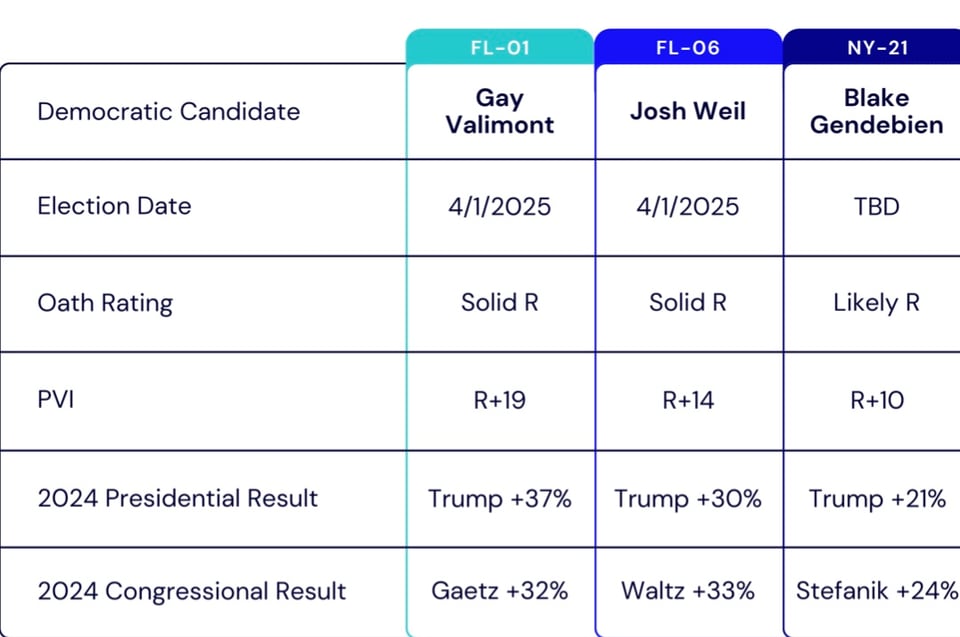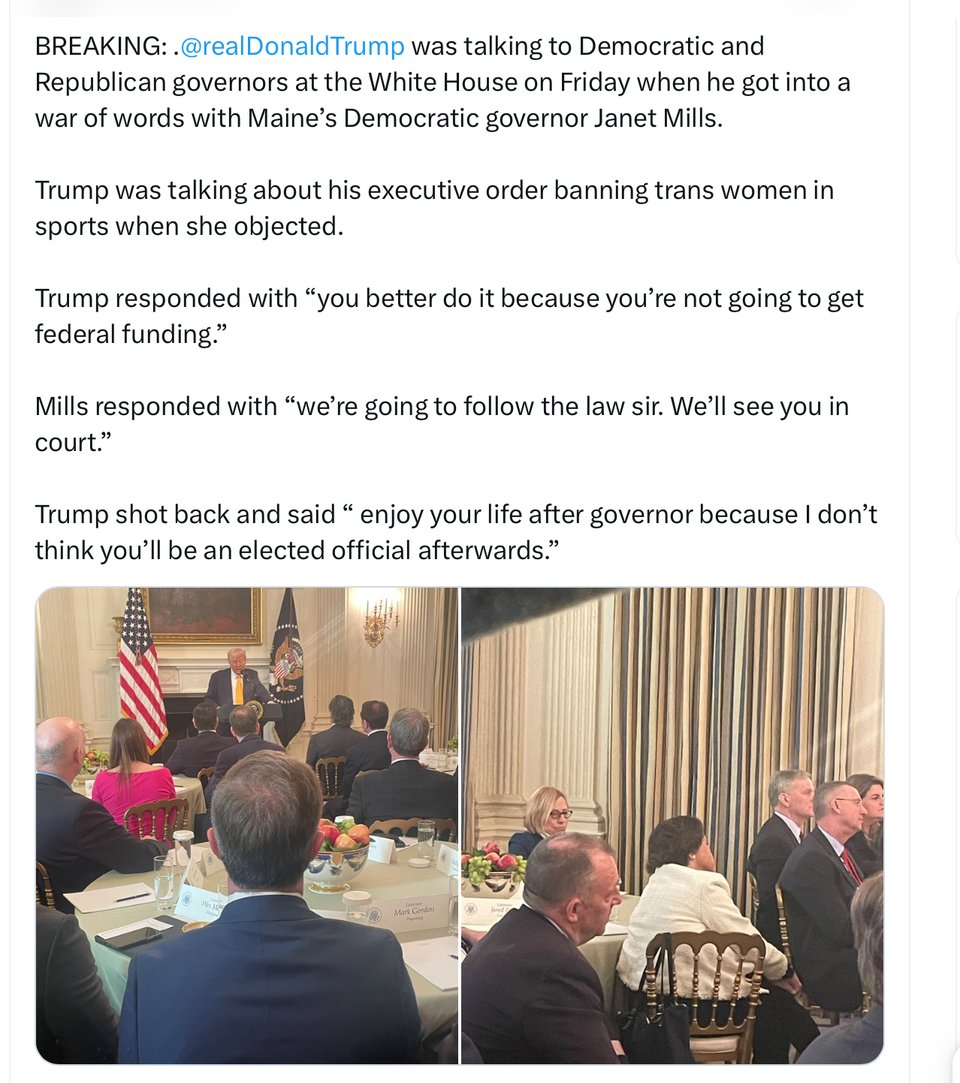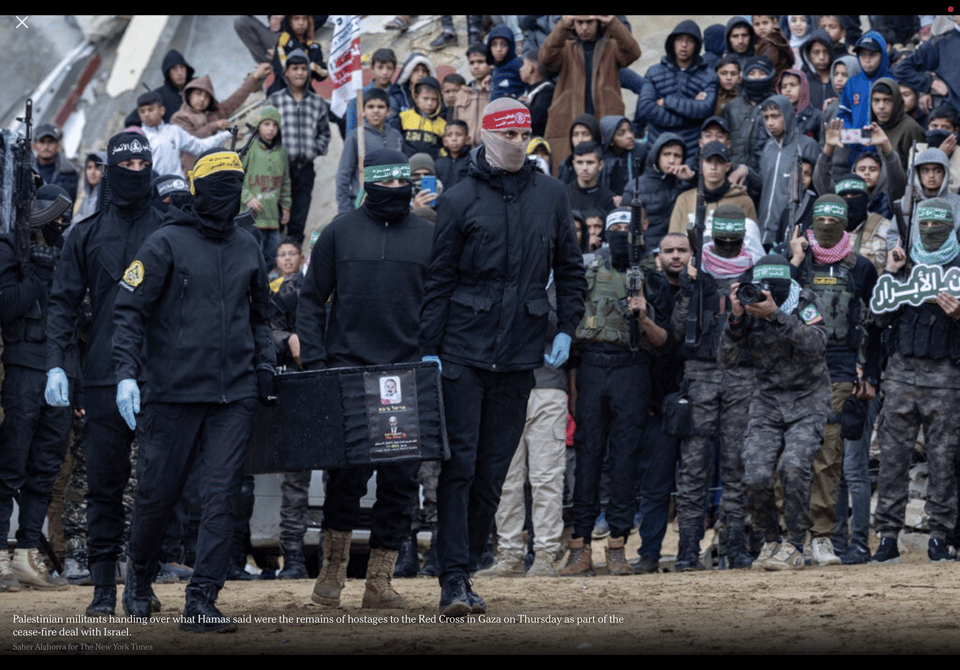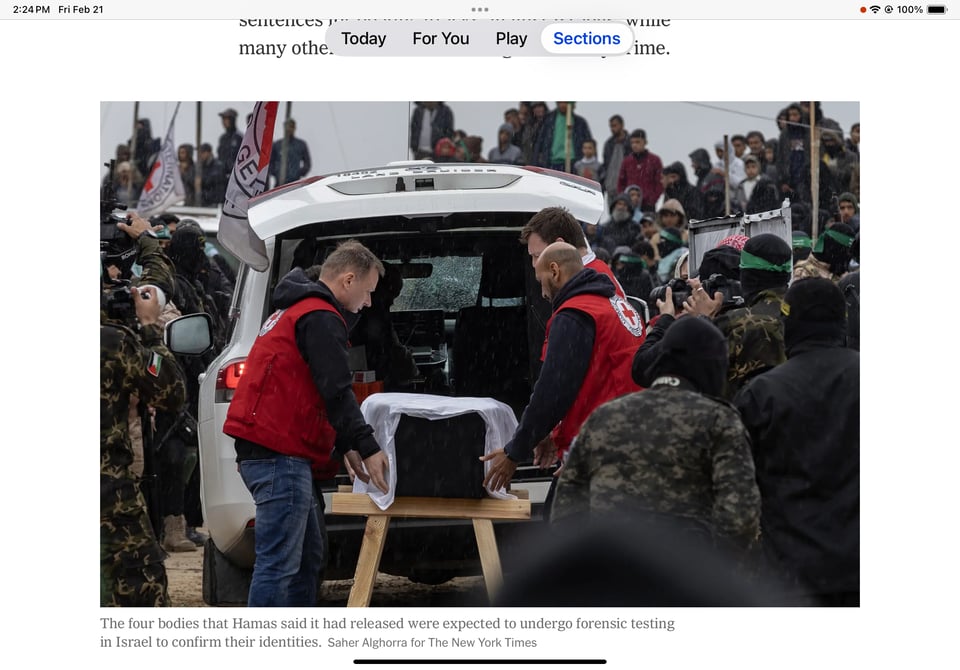Saturday, February 22, 2025. Annette’s Roundup for Democracy.
How to win elections where Red votes have dominated.
How to Win, According to a Democrat Who Just Did in Trump Country
A question for Democrats: How did you spend the weeks around Donald Trump’s presidential inauguration? Moping? Doom scrolling? Ordering in?
Mike Zimmer had no time for any of that. He was running in a special election for an Iowa State Senate seat, in an eastern pocket of the state that had gone for Mr. Trump by 21 points in November. A longtime educator, Mr. Zimmer spent January introducing himself to voters via phone banking, social media videos, podcasts, postcards, media interviews and relentless canvassing. In a month’s time, Team Zimmer knocked on more than 7,700 doors.
“I am not going to sit here and talk about, ‘Oh, at every doorstep we knocked, everyone’s having policy conversations,’” Mr. Zimmer said with a chuckle in a recent phone interview. “They were like, ‘I saw you on the television, I’ve gotten three of your fliers, and oh, by the way, you’re letting $20 worth of heat out the door.’”
Nevertheless, he persisted. And, defying the odds, he won, flipping a Republican seat and beating his opponent by around four points. He was just sworn in to the Iowa Senate.
After the electoral thumping the Democrats suffered in November, it will take more than a down-ballot upset here and there for the party to regain its mojo. But this is how the rebuilding starts. The wounded party begins clawing back voters and territory, often in unglamorous contests.
Practically speaking, it can be easier to win these one-off contests, far from the presidential scrum. The Democrats can test-drive messages and candidates mostly under the radar of the national Republican Party (and political media). The candidate can focus on bread-and-butter issues with less risk of getting swept into the polarized chaos of the national scene. This happened for Democrats with special elections in 2017, after Mr. Trump’s team dominated the 2016 cycle. And Mr. Zimmer’s unexpected success has some in his party dreaming of a similar surge this year. In recent weeks, his campaign team has been fielding calls from Democratic strategists and players far beyond Iowa, all eager to know how the campaign did what it did and which elements could be exported to other places and races.
It goes without saying — but let’s say it anyway — that candidate quality matters. And “you couldn’t use a computer to generate a better candidate” for his district than Mr. Zimmer, said Tyler Redenbaugh, the executive director of the Iowa Senate Majority fund and the chief architect of the Zimmer campaign. The candidate grew up in the area and after college worked as an educator in schools all across the district. His campaign motto was no frills — “Iowa raised, Iowa values: hard work and fairness.” And his focus was on kitchen-table issues like lowering costs, raising wages and improving public schools.
“We stayed on the economic,” Mr. Zimmer said. “Going down the cultural wars right now, that’s not going to get you anywhere.”
With only a few weeks to introduce himself to voters, Mr. Zimmer went all in. “He talked to everybody, from the big Quad Cities TV stations to random podcasts,” Mr. Redenbaugh said. “We went everywhere and talked to as many people as we could. That was the secret sauce.”
That sauce included a big dollop of social media. “He did a lot of short-form videos, unscripted, with him going straight to camera talking about whatever issue was on his mind,” Mr. Redenbaugh said. The videos, like the campaign overall, were done on a tight budget, and they are unpolished — much like Mr. Zimmer. But that was part of the appeal, Mr. Redenbaugh argued. “We were creating content that was humanizing.”
It helped that the Republican in the race did not seem as keen to do interviews or public appearances. At a public forum hosted by the local Chamber of Commerce, Mr. Zimmer was the only candidate to show up. (His opponent reportedly was ill.) “That left me with the whole hour to answer every question from wind turbines to carbon sequestration to public funding. You name it!” he recalled.
The candidate’s charms aside, the campaign’s ground game was on point. Special elections are odd creatures: The timeline is compressed — this one lasted about a month — so the party needs to get its candidate up and running quickly. The Democrats did that, Mr. Redenbaugh said, thanks to their Senate leader, Janice Weiner, who reached out to party players in the district as soon as it was known that the seat was coming open. (The seat’s previous occupant, Chris Cournoyer, a Republican, had been appointed to serve as lieutenant governor.)
Despite the bad odds of taking a G.O.P.-held seat in a Trump district, the campaign began aggressively executing the tricky two-step called for in special elections. These races “are all about turning out your base,” Ms. Weiner said. Ideally, you want to mobilize your party’s supporters in a low-key, focused way that avoids reminding your opponent’s supporters that there is an election coming up at all. The campaign was “really careful about how it targeted people,” Ms. Weiner said. “It was not our goal to get out all voters. We just wanted to get our voters out.”
To guide this process, a campaign needs good survey data about which doors to knock on and which phones to call. Targeted mailings and targeted digital messaging are more effective than blasting out ads across mass media. Also, it’s wise to go easy on yard signs in certain neighborhoods.
As for reaching friendly voters, the campaign relied on a lot of old-fashioned “elbow grease,” Ms. Weiner said. This meant casting a wide net for volunteers. “We pulled in volunteer power from neighboring counties,” she said, “as well as phone-banking help from counties not so close by. It was also a great opportunity for county parties to organize and help, as well as trade unions.”
“This really makes all the grass roots folks here feel really good,” Ms. Weiner said. “We essentially banded together, organized and got it done” — and without the financial support of the national party. “It is obviously a big boost.”
Stella Sexton is among the Democratic officials looking to capture some of that energy for her state, Pennsylvania. As the vice chair of the party in Lancaster County, a red enclave about an hour’s drive west of Philadelphia, she is working on the special election of James Malone, the Democratic running for the State Senate in her district.
Ms. Sexton has been talking with Team Zimmer, and her biggest strategic takeaway is that “they really did everything they could not to remind Republicans that there was an election.”
There are, of course, other takeaways — and plenty of similarities between the two races. Mr. Malone, the mayor of East Petersburg, is running in a district that went for Mr. Trump by double digits. Like Mr. Zimmer, he is focusing on bread-and-butter issues such as housing, education, support for first responders and “lowering the cost of everyday essentials,” as his campaign literature pledges. Also like Mr. Zimmer, with Election Day set for March 25, he has vanishingly little time to get his message out.
“This really makes all the grass roots folks here feel really good,” Ms. Weiner said. “We essentially banded together, organized and got it done” — and without the financial support of the national party. “It is obviously a big boost.”
Stella Sexton is among the Democratic officials looking to capture some of that energy for her state, Pennsylvania. As the vice chair of the party in Lancaster County, a red enclave about an hour’s drive west of Philadelphia, she is working on the special election of James Malone, the Democratic running for the State Senate in her district.
Ms. Sexton has been talking with Team Zimmer, and her biggest strategic takeaway is that “they really did everything they could not to remind Republicans that there was an election.”
There are, of course, other takeaways — and plenty of similarities between the two races. Mr. Malone, the mayor of East Petersburg, is running in a district that went for Mr. Trump by double digits. Like Mr. Zimmer, he is focusing on bread-and-butter issues such as housing, education, support for first responders and “lowering the cost of everyday essentials,” as his campaign literature pledges. Also like Mr. Zimmer, with Election Day set for March 25, he has vanishingly little time to get his message out. (New York Times).
Can we take back the House on April 1st?
Here are the 3 House seats with special elections on April 1. These are the seats the GOP needs to keep for control of the House.

These 👆 are surely long shots, but, as the Mike Zimmer case in the New York Times article above makes clear, a good hard working candidate with a well financed, motivated campaign can pull off an upset.
Special elections have lower turnout so they can be harder to predict. It is not impossible that one or more of these seats could flip to Democratic control.
Zimmer shows long shots can happen. But they cannot happen without you.
Here is the success story of Dante Pittman in North Carolina House District 24 - a perfect example of how grassroots donors can be a decisive factor in what might seem to be unwinnable races.
Pittman’s campaign encouraged more than 2,500 donors to give to his race. These donors saw opportunity where cash could actually make a difference, and it worked.
Dante won by only 871 votes, breaking Republicans’ supermajority in the N.C. General Assembly, giving veto power to North Carolina’s Democratic governor.
We all know if Trump is allowed to continue to pack the House with his henchmen, he can continue to damage Democracy. It is up to us to stop him.
Money makes the difference. You may not have the deep pockets of Elon Musk and Trump’s oligarchs, but you know these truths:
- a little spark can start a great fire. $5, $20, $100, or $1,000.
- small donors inspire the candidates they support, and deliver volunteers and voters.
- good can triumph over evil.
Here is a linkto help all 3 races if you feel inclined. Donors like us are how we win.
One more thing.
From Oath- If you are looking for other meaningful ways to translate your outrage into action, we recommend focusing on the Wisconsin Supreme Court race.
Scheduled for the same date as the Florida special elections, this race is a clear Toss Up and the Court majority is at stake. Wisconsin’s highest court has delivered major wins on reproductive rights, voting rights, and fair maps but all of that could be rolled back if we lose this seat. We recommend putting your entire February budget into this race.
Here is a link to donate to Susan Crawford’s campaign for the recently vacated seat on Wisconsin’s Supreme Court. Election Date is April 1.
Janet Mills, Governor of Maine, shows how to lead.
Thought you should see this.


The Governor of Maine.
Some resistance in Republican ranks.
We have to remember to count, rather than to despair.

These two Senators voted for Bobby Kennedy Jr. and Tulsi Gabbard They didn’t vote for Hegseth or Kash Patel.
But this happened on Wednesday.
Murkowski: I would certainly never refer to President Zelenskyy as a dictator. It is quite clear who started the war. It was absolutely Russia at Putin's directive.
— Acyn (@Acyn) February 20, 2025
Collins: I do not agree that President Zelenskyy is to blame in any way. pic.twitter.com/hbfNsL7a61
We already posted that Republicans Senators John Kennedy (LA) and Roger Wicker (MS) have spoken against Trump on Ukraine. Now, add Senators Susan Collins (ME) and Lisa Murkowski (AK) to this list.
Here is another.
BREAKING: In an unbelievable moment, Republican Senator Thom Tillis breaks away harshly from Trump's policy on Ukraine, calling Vladimir Putin "a cancer, and the greatest threat to democracy in my lifetime."
— Really American 🇺🇸 (@ReallyAmerican1) February 21, 2025
Make sure everyone sees this.pic.twitter.com/G7p1OxyXAy
The divide in the Senate is 53 Republicans to 47 Democrats and Independents. If these 5 Republicans vote with the Democrats on Ukraine, the tally would be 49 to 52, Republicans to Dems.
Trump, be scared! Be very scared.
Another of Trump’s January 6th “great patriots” is arrested.
BREAKING: Former Proud Boys leader Enrique Tarrio, who was released from prison last month after Trump pardoned him along with 1,500 other Jan. 6 rioters, has just been arrested by Capitol Police for assaulting a counter-protester.
— Republicans against Trump (@RpsAgainstTrump) February 21, 2025
pic.twitter.com/IGKG1Ij4q6
Good Palestinians deserve better leaders than the barbarians of Hamas.
If you absolutely can’t tolerate reading about humans who treat other humans savagely, please don’t read this. I could barely read it.
You don’t have to support Israel’s behavior in Gaza or Trump’s intention to move the Palestinians from Gaza and develop the “Riviera of the Middle East” to reject Hamas.
With Coffins and Taunts, Hamas Hands Dead Hostages to Israel.

Hamas said it handed over four hostages to Israel in a display a senior U.N. official called “abhorrent and cruel.” Israel later said only three bodies belonged to captives.
Hamas handed over on Thursday what it said were the remains of four Israelis taken hostage during the Oct. 7, 2023, attack on Israel, including two young children whose abduction was widely seen as emblematic of the viciousness of the Hamas assault.
But early on Friday morning, the Israeli military said that only three of the bodies belonged to the hostages slated to be handed over. They were Oded Lifshitz, 83, a retiree and a peace activist; Ariel Bibas, 4; and Kfir Bibas, 10 months old; according to Israeli officials.
The fourth body was supposed to be the children’s mother, Shiri Bibas. But Israeli forensic testing found it did not belong to her, the Israeli military said, describing it as a “violation of the utmost severity” of the ongoing cease-fire.
The shocking claim, sure to set off widespread anger and revulsion across Israel when the country wakes up to the news, threw the truce’s next steps into doubt after an already tense day that had ignited a torrent of emotion in the country.
Hamas said the four hostages were killed by Israeli airstrikes. The Israeli authorities said the two Bibas children were “brutally murdered by terrorists,” and that Mr. Lifshitz had been “murdered in the captivity of Palestinian Islamic Jihad” without providing further details. Neither claim could be immediately verified.
Crowds of Palestinians had gathered near the southern Gaza city of Khan Younis to watch the theatrical handoff staged by Hamas that morning: Four coffins placed on a stage in front of a cartoonish, vampiric picture of Benjamin Netanyahu, the Israeli prime minister. Triumphant music thumped in the background.
One casket bore a picture of Kfir Bibas, who was less than 9 months old when he was kidnapped. A few yards away, a poster threatened that if Israel went back to war against Hamas, even more hostages would return in coffins.
Miles away, Israelis watched the scene unfold in horror and anguish, a sharp contrast to the catharsis evoked by the recent releases of hostages who had survived. Israel’s leaders had vowed to topple Hamas and bring home the roughly 250 hostages the militant group and its allies abducted in October 2023.
But some of those taken captive are now coming home dead.
Critics in Israel say Mr. Netanyahu shares at least part of the blame, arguing that he pressed on with his campaign against Hamas rather than agreeing earlier to a cease-fire that would have saved some lives.
And despite more than a year of devastating war, Hamas’s show of force at the exchange demonstrated that the group was still very much in charge in Gaza. Scores of gunmen — most clad in green Hamas headbands — patrolled the area around the handoff.
On Thursday, the coffins containing remains were the latest props. Volker Türk, the United Nations high commissioner for human rights, called the display “abhorrent and cruel,” adding that it “flies in the face of international law.”

Israel and Hamas are now in the final weeks of a 42-day cease-fire that began in mid-January. As part of the truce, Hamas agreed to turn over 25 living Israeli hostages and the bodies of eight others in exchange for more than 1,500 Palestinian prisoners held by Israel.
In exchange for the bodies, Israel was expected on Saturday to free women and minors from Gaza who were detained during the war, generally without formal charges. But the latest accusations from Israel over the failure to turn over Ms. Bibas’s body threw that into doubt.
The Hamas-led surprise attack in October 2023 killed about 1,200 people, including Ms. Bibas’s parents, according to Israel. Israel’s relentless campaign against Hamas in Gaza quickly followed, killing tens of thousands of Palestinians and leaving much of the enclave in ruins.

In Israel, right-wing politicians, including Mr. Netanyahu, reiterated furious calls for revenge against Hamas in the wake of the handover. Others saw the return of the bodies as another sign of how important it was to immediately bring home the remaining captives.
“Next to the sadness, it underlined to me that the most critical thing now is to bring them all back,” said Bar Goren, 24, whose parents were both killed in the Oct. 7 attacks. “Everyone deserves this closure.”
Isaac Herzog, the Israeli president, said “there are no words” for the agony of seeing the coffins. Many Israelis are now familiar with the names and faces of the hostages, whose images have been ubiquitous in the country since their abduction.
“Our hearts — the hearts of an entire nation — lie in tatters,” Mr. Herzog wrote on social media. “On behalf of the State of Israel, I bow my head and ask for forgiveness. Forgiveness for not protecting you on that terrible day. Forgiveness for not bringing you home safely.”

Ms. Bibas’s husband, Yarden Bibas, was also abducted. In footage from the scene that is now seared into Israel’s national memory, a terrified Ms. Bibas — covered with a blanket — could be seen clutching Ariel and Kfir to her chest as she is taken away by armed militants.
In November 2023, Hamas published a statement announcing the deaths of Ms. Bibas and the two children. The group also published a propaganda video featuring a sobbing Mr. Bibas, while still in captivity, responding to the news. Human rights groups have said such videos amount to war crimes.
Mr. Bibas was freed in early February as part of the ongoing cease-fire agreement.
Mr. Lifshitz, a retired journalist, was taken alongside his wife, Yocheved Lifshitz. Hamas later freed her for what it said were “humanitarian reasons” but refused to release her husband. Before the war, Mr. Lifshitz had volunteered to drive Gazans seeking medical treatment in Israel to hospitals.
Both Israelis and Palestinians have seen emotional homecomings in recent weeks. Israeli hostages, many of them thin and pale, reunited with their families after many months in Hamas’s warren of underground tunnels.
And Palestinian prisoners — some of whom also emerged from Israeli jails appearing gaunt — also embraced loved ones. Some had been serving life sentences for deadly attacks against Israelis, while many others had not been charged with any crime.

On Saturday, Hamas had been expected to free the last six living hostages covered in the first phase of the cease-fire in exchange for more Palestinian prisoners. The remains of four others will be released the following weekend.
It is unclear now whether those exchanges will go forward as planned. But even if both sides manage to surmount the latest obstacle, the future of the truce after the first stage, set to expire in early March, is still shrouded in uncertainty.
Israel and Hamas have not agreed on terms to extend the agreement into a new phase that would conclusively end the war, free the remaining hostages and see a full withdrawal of Israeli forces.
President Trump has pressured both sides to clinch such a deal. But Israel has refused to countenance any Hamas control in Gaza, while Hamas has shown little appetite for disbanding its battalions of armed fighters or sending its Gaza leaders into exile.
Steve Witkoff, Mr. Trump’s Mideast envoy, said during a conference in Miami Beach on Thursday that reaching the next stage of the deal would be difficult, in part because of Israel’s red line on Hamas governance.
“It’s hard to square that circle,” Mr. Witkoff said. “But we’re making a lot of progress in the conversations and hopefully it will lead to some good things, good results.” (New York Times).